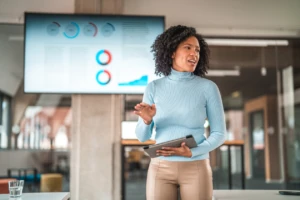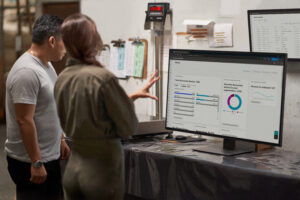
Futureproof the mining industry with AI and digital innovation
Mining companies are navigating the complex challenges reshaping industries worldwide. The global energy transition is at the forefront, with investors calling for sustainable practices and heightened accountability.1
Digital transformation is essential for a resilient, durable, and sustainable mining sector. Geopolitical volatility and trade uncertainties are disrupting supply chains, while the industry grapples with the challenges of meeting the soaring demand for minerals essential for the energy transition.
Existing deposits are being exhausted and new deposits are increasingly more difficult and expensive to discover. In 2015, McKinsey & Company reported that worldwide mining operations were 28% less productive than they were a decade prior, even after adjusting for declining ore grades.2 Nearly a decade later, the shortage now impacts the availability of metals creating a potential risk for a near-term supply shortfall, particularly for copper, lithium, and cobalt vital to the energy transition. There is an expected supply deficit in critical minerals like copper with a potential shortfall of 9.9 million tons by 2035.3
The mining industry also faces a chronic labor shortage which adds even more to its challenges, with 86% of mining executives finding it increasingly difficult to recruit and retain necessary talent.4 Amidst these complexities, mining companies are striving to balance productivity and profitability with purpose using cloud-based platforms, the Internet of Things (IoT), mixed reality, and more recently, generative AI.
Microsoft for Energy and Resources
Achieve more in the energy and resources industry with trusted solutions from Microsoft

Accelerating digital transformation
In the December 2023 blog, I discussed how mining companies are adopting digital technologies to enable business agility, drive efficiency, and accelerate innovation across the entire mining value chain, from exploration and extraction to processing and transportation. While these efforts have traditionally centered around specific business outcomes, current trends emphasize broader goals such as corporate environmental, social, and governance (ESG) targets and the transition to net-zero emissions.
Meeting these goals requires a strong data foundation, digital effectiveness, and digital maturity. Transformation starts with technology-savvy leaders who have a grounding in AI and a focus on sustainability. With a vision informed by a clear understanding of their organization’s challenges and opportunities, effective leaders can take a leap forward on their innovation roadmap with solutions like Microsoft Intelligent Data Platform, which provides a single, flexible platform for databases, analytics, AI, and data governance.
Digital maturity deepens with an empowered, skilled workforce that harnesses AI to make informed decisions and streamline repetitive tasks, gaining more time for value-added activities. For example, in my last blog, I shared how Microsoft Copilot for Microsoft 365 in Microsoft Dynamics 365 Guides combines generative AI with mixed reality to help frontline workers in industrial settings complete complex tasks and resolve problems faster for minimal downtime and accelerated learning.
Exploring innovation with a future-ready mindset
At Microsoft, our enduring mission is to “empower every person and organization on the planet to achieve more.” We are privileged to work with a partner ecosystem that shares our vision.
Digital innovation that stays relevant over time integrates people, processes, technology, and information. Multinational Japanese firm Asahi Kasei Group and ZEAL Corporation showcased that approach by implementing a data management platform based on Microsoft Azure Data Factory, Microsoft Purview, and Microsoft Azure Synapse Analytics. The platform unifies 1,200 systems across multiple diverse operations such chemicals, healthcare, electronics, construction, materials, services, and engineering. By eliminating data silos, the team can gain new insights that unlock business advantages.
Siemens is another great example of enabling people to achieve more. To empower employees, the company created an AI-powered collaboration app based on Microsoft Azure OpenAI Service and Microsoft Teams. Siemens aimed to enhance innovation, efficiency, and problem-solving agility by connecting field and shop floor workers with operations and engineering teams. Now, frontline workers who find problems in the design and manufacturing process can easily connect with engineers to resolve them.
Employees can receive notifications, create problem reports, and collaborate on tasks on any device. The app provides preconfigured industrial machinery solutions and accelerates knowledge-sharing with an AI-powered natural language interface. For instance, employees can report issues in their own language, which is automatically translated into a common language.
In my final example, Schieder Electric wanted to speed innovation for key goals such as reducing carbon emissions. With a vast portfolio of connected devices, solutions, and services, AI has become essential for generating data-driven insights and actions The company is using multiple AI services to fast-track innovation, including Microsoft Copilot, Microsoft Cloud for Manufacturing, Azure OpenAI, and Azure Machine Learning. Schneider Electric is using Copilot to automate routine tasks and to offer intelligent code suggestions that streamline programmable logic controller (PLC) programming. The company has also created bots to help with customer service and financial analysis.
Creating durable innovation for a sustainable future
Digital transformation can be a long journey, and the pressing issues of today can sometimes overshadow our efforts toward growth and innovation. For durable innovation, we incorporate the McKinsey Three Horizons Model into our digital transformation roadmaps.
The model provides a structured approach that miners can use to allocate resources effectively, balancing immediate business needs with sustained innovation for future success. Organizations are encouraged to explore new markets and invest in business models, products, and technologies that align innovation programs with future challenges and growth opportunities. As a framework for strategic innovation and growth, Three Horizons Model can support miners during times of change, disruption, and uncertainty.
In addition to innovation initiatives, we consider critical aspects such as user adoption, change management, change fatigue, organizational capabilities, culture transformation, workforce reskilling, and governance. These considerations are vital for futureproofing the mining enterprise and sustaining digital and AI innovation.
How Microsoft can help
Digital transformation and AI adoption are poised to revolutionize the mining industry in the next decade and beyond. Microsoft technologies are already making a significant impact, with improvements in safety, productivity, profitability, safety, health, and environmental performance. From clarifying your vision for innovation and identifying top challenges to creating your solution roadmap, a disciplined approach is crucial for continuing this momentum.
The digital sustainable mine of the future integrates physical, digital, and sustainable elements with information, innovation, and human ingenuity. The adaptive, resilient, forward-thinking mine offers a customizable reference model and roadmap to help mining organizations achieve their vision for the future.
That vision isn’t just about the outcome, or business impact—it’s about investing in the processes and technologies that enable the mining industry to adapt to change and help us all accelerate toward a sustainable tomorrow.
Learn more about Microsoft solutions
- Microsoft for Energy and Resources
- Microsoft Industry Blogs: Energy and Resources
- Microsoft AI solutions
- Microsoft Azure AI Services
- Microsoft Intelligent Data Platform
1Mining’s top ten ESG trends for 2024, Mining.com.
2Productivity in mining operations: Reversing the downward trend, McKinsey & Company.




